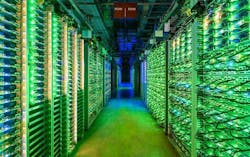Google is building more data centers in more places than ever before. Although the torrid pace of hyperscale data center leasing has moderated this year, Google appears likely to make good on its pledge to invest $13 billion in new data center campuses in 2019.
Google has opened new data centers in Northern Virginia and Tennessee in 2019, and broken ground for future campuses in Texas, Ohio and Nevada. The company has announced plans for a site in Nebraska, but has yet to confirm a location (although it is the prime suspect in a huge “codename” project near Lincoln). Google has also negotiated an incentive package to join the crowd of data center developers planning to build in Mesa, Arizona.
The building boom extends overseas as well. In September, Google said it will invest 3 billion Euros ($3.3 billion US) over the next two years to expand its data center footprint in Europe, along with 10 new projects to generate renewable energy for its servers.
Google’s 2019 investment is notable for both the geographic breadth of its new deployments and the drive for greater scale seen in the expansion of existing cloud campuses. The search leader is expanding upon existing cloud computing nodes in Oklahoma, South Carolina and Finland.
The scale of Google’s infrastructure is remarkable. The company now has 19 data center campuses around the globe, with 11 in the United States, 5 in Europe, two in Asia/Pacific and one in South America. These cloud campuses house multiple buildings, each approximately twice the size of a Wal-Mart and filled with servers and storage to manage data. Google typically spends more than $1 billion to complete an entire campus, with some sites exceeding $2 billion in investment.
Google executives say the company is building for a future powered by digital infrastructure.
“The impact of cloud computing is massive,” said Daniel Golding, the Global Network Planning and Design Lead for Google. “We’re seeing massive, massive growth in our cloud lines of business. We’re also seeing a lot of growth in what used to be called SaaS. I really think the sky is the limit.”
The Capacity Challenge: Preparing for A Bigger Cloud
On one level, Google has always been an outlier. Google is on the bleeding edge of data center technology, customizing nearly every element of its operations, from processors to building design. Google has recently shifted to liquid cooling with its latest hardware for artificial intelligence, as the heat generated by its new Tensor Processing Units (TPUs) has exceeded the limits of its previous data center cooling solutions. That’s not an everyday computing problem for most folks.
Google is often a bellwether for trends that will make their into the broader data center industry. Is its building boom of 2019 a leading indicator?
But Google has often been a harbinger of things to come, the ultimate early adopter of trends and innovations that will make their way into the broader data center industry.
Thus, the Google building boom of 2019 could be a leading indicator. Unless Google has massively missed the mark, their dramatic expansion heralds a continuing expansion of digital infrastructure to support next-generation technologies.
Projecting future data center capacity is a challenge for every company, but especially so for cloud service providers, which provision space at greater scale and speed than enterprises. Google has entire teams focused on modeling demand and future capacity needs. Google Vice President of Data Centers Joe Kava says the process is “very rigorous,” especially in projecting demand for cloud services.
“When we build data centers for our own products, we were able to stay ahead of the demand,” Kava told Data Center Frontier in a 2017 discussion. “You have historic data you can work with to make projections. Now we’re not just building for our own products. With the public cloud, you’re building for everyone else’s products.”
Kava noted the challenges of hosting customers who struggle to estimate their needs, with Niantic’s launch of Pokemon Go being a prime example. “When they gave us their day one estimates, they were only off by a factor of 40X,” Kava said.
Forging Ahead With Data Center Construction
Google’s capacity planning is prompting the company to keep its foot on the accelerator with its data center construction. It has continued to build in 2019, even as several of its rivals have temporarily scaled back on leasing new capacity as they digest the space they’ve already provisioned. Google diverges from its cloud rivals by continuing to build its own data centers, rather than leasing space from data center REITs.
Google’s four-story data center on its cloud campus in Mayes County, Oklahoma. (Photo: Google)
One example of this is Google’s growth in Northern Virginia, where hyperscale growth has cooled in 2019. Google has been building two large data center campuses in Loudoun County, with a total expected investment of $1.2 billion. The Arcola campus opened in October, and the company is well along in the development of another campus near Leesburg.
In recent years, the company’s digital infrastructure has extended well beyond servers and data centers.
“We’ve made a major investment over the last few years in new data centers, new subsea cables, more CDN points, and an edge network,” Golding said at a recent CAPRE conference.
Google and other hyperscale computing players are reshaping how data flows around the world, rerouting undersea lanes to target new markets and bring traffic ashore near their giant data center campuses. That includes a private subsea cable to manage data traffic between Europe and its huge cloud campuses in Northern Virginia. The Dunant cable will provide a high-bandwidth path for Internet traffic from the west coast of France across the Atlantic, landing in Virginia Beach. Once that traffic arrives in Virginia Beach, much of it will be forwarded to Google’s new data centers in Loudoun County.
In June, Google revealed plans for a new private subsea cable that will connect Africa with Europe. The Equiano cable will start in western Europe and run along the West Coast of Africa, between Portugal and South Africa, with branching units along the way that can be used to extend connectivity to additional African countries. In November, Google activated the Curie cable, another private cable that will deliver Google data traffic between Los Angeles and the company’s data center campus in Chile.
Here’s a video offering a closer look at Google’s subsea cable operation and the Curie project.
Investing to Power the Future
Data centers and subsea cables are among the most expensive, capital-intensive projects in the world of infrastructure. Google’s commitment is reflected in its capital expenditures, or CapEx, which remains the best available public measure of digital infrastructure spending.
In 2018, Google had record capital expenditures of $25.46 billion. Through the first three quarters of 2019, the company’s CapEx has already reached $21.8 billion, meaning that it will likely smash through that record by year-end.
Google also expects that the super-sizing of hyperscale data center campuses has a long way to go. The steadily growing requirements in recent years indicate that hyperscale players are intensifying their focus on long-term capacity planning.
Google was an early pioneer in these data center hubs, which offer economies of scale, enabling companies to rapidly add server capacity and electric power as more workloads shift from in-house IT rooms into these massive server farms. It has become routine for hyperscale companies like Google to invest more than $1 billion in a single location where they place a cloud campus. Google’s
“I think the data centers we’re building will continue to get larger,” said Golding. “The economics are heavily in favor of large data centers. I think this will continue.”






